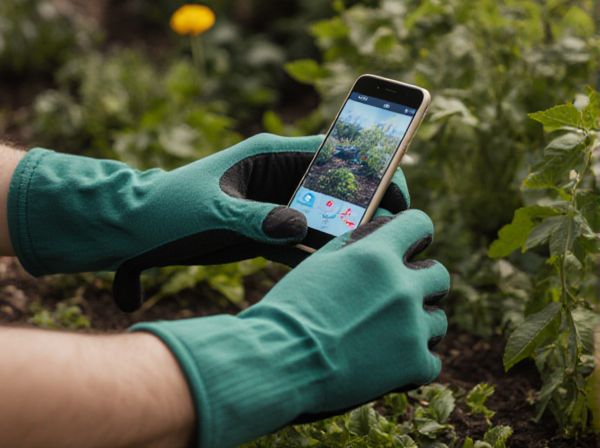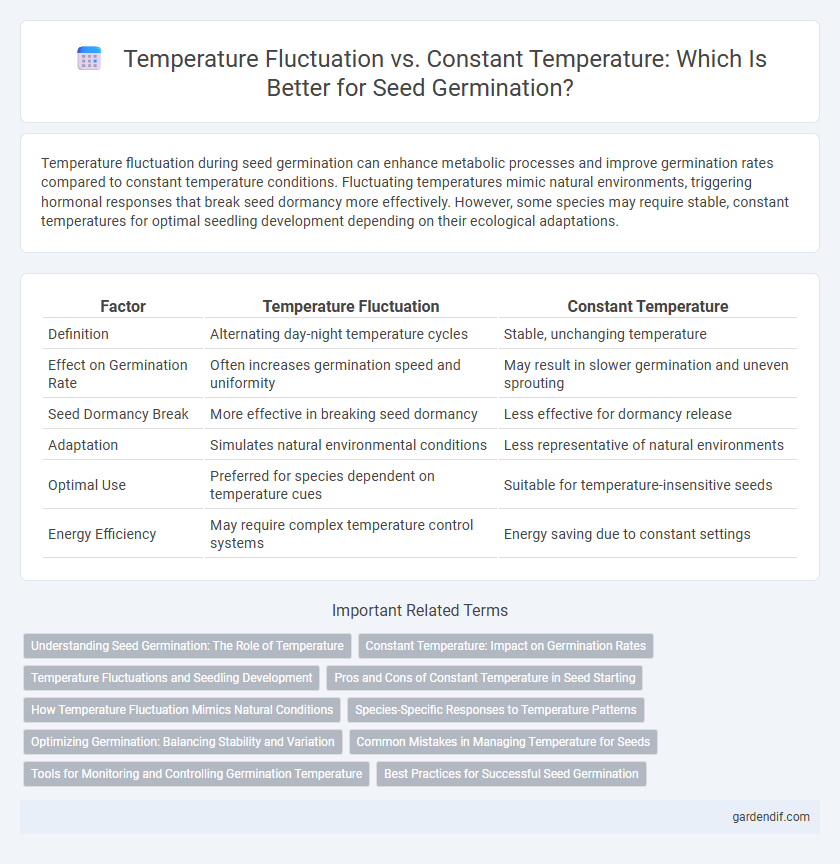
Temperature Fluctuation vs Constant Temperature Illustration
Temperature fluctuation during seed germination can enhance metabolic processes and improve germination rates compared to constant temperature conditions. Fluctuating temperatures mimic natural environments, triggering hormonal responses that break seed dormancy more effectively. However, some species may require stable, constant temperatures for optimal seedling development depending on their ecological adaptations.
Table of Comparison
| Factor | Temperature Fluctuation | Constant Temperature |
|---|---|---|
| Definition | Alternating day-night temperature cycles | Stable, unchanging temperature |
| Effect on Germination Rate | Often increases germination speed and uniformity | May result in slower germination and uneven sprouting |
| Seed Dormancy Break | More effective in breaking seed dormancy | Less effective for dormancy release |
| Adaptation | Simulates natural environmental conditions | Less representative of natural environments |
| Optimal Use | Preferred for species dependent on temperature cues | Suitable for temperature-insensitive seeds |
| Energy Efficiency | May require complex temperature control systems | Energy saving due to constant settings |
Understanding Seed Germination: The Role of Temperature
Temperature fluctuctuation during seed germination significantly influences enzymatic activity and dormancy break, often enhancing germination rates compared to constant temperature conditions. Seeds exposed to daily temperature cycles tend to synchronize metabolic processes, promoting uniform sprouting and improving seedling vigor. Understanding these temperature dynamics is crucial for optimizing germination protocols in agriculture and ecological restoration.
Constant Temperature: Impact on Germination Rates
Constant temperature provides a stable environment that often enhances seed germination rates by maintaining optimal enzymatic activity and metabolic processes. Seeds exposed to consistent temperatures typically exhibit uniform and faster germination compared to those under fluctuating temperatures, which can cause stress and delay. Studies show that maintaining a steady temperature tailored to the specific seed species significantly improves germination success and seedling vigor.
Temperature Fluctuations and Seedling Development
Temperature fluctuations during germination create dynamic environmental signals that enhance seedling development by optimizing enzyme activity and metabolic processes. Variable temperatures promote hormonal balance and cellular differentiation, leading to stronger root and shoot growth compared to constant temperature conditions. Seeds exposed to temperature fluctuations typically exhibit higher germination rates and improved stress resilience in early seedling stages.
Pros and Cons of Constant Temperature in Seed Starting
Constant temperature during seed starting ensures uniform germination rates and reduces stress on seeds, promoting consistent seedling development. However, it may limit the natural cues seeds rely on to break dormancy, potentially leading to slower or uneven germination for species adapted to temperature fluctuations. Overreliance on constant temperature can also increase the risk of fungal diseases due to stagnant environmental conditions.
How Temperature Fluctuation Mimics Natural Conditions
Temperature fluctuctuations during germination more accurately replicate natural environmental conditions, promoting seed dormancy break and enhancing germination rates in many species. Many seeds rely on alternating temperatures to trigger physiological processes essential for uniform germination, reflecting day-night or seasonal cycles. Constant temperature often lacks these cues, potentially resulting in slower or incomplete germination compared to fluctuating temperature regimes.
Species-Specific Responses to Temperature Patterns
Temperature fluctuations during germination impact species differently, with some plants exhibiting higher germination rates under alternating temperatures while others prefer constant thermal conditions. Seeds of species such as lettuce and lettuce relatives often require diurnal temperature variations to break dormancy and initiate growth, whereas crops like wheat and barley tend to germinate successfully under steady temperature regimes. Understanding these species-specific temperature responses enables optimization of sowing strategies and improves germination success in agricultural production.
Optimizing Germination: Balancing Stability and Variation
Temperature fluctuation during germination can enhance seedling vigor by mimicking natural soil conditions, promoting faster and more uniform germination compared to constant temperature. Seeds subjected to alternating temperatures often show improved metabolic activity and enzyme function critical for breaking dormancy. Optimizing germination requires balancing stability with variation, adjusting thermal regimes to species-specific thresholds to maximize germination rates and seedling establishment.
Common Mistakes in Managing Temperature for Seeds
Common mistakes in managing seed temperature during germination include maintaining constant temperatures that do not mimic natural diurnal fluctuations crucial for triggering enzyme activity and breaking dormancy in many species. Overlooking the value of temperature oscillations of around 5-10degC can hinder optimal germination rates, especially in seeds adapted to seasonal environments. Excessive temperature stability often leads to poor seedling vigor and increased susceptibility to pathogens due to reduced physiological stress responses.
Tools for Monitoring and Controlling Germination Temperature
Accurate seed germination temperature monitoring relies on digital thermometers and data loggers providing real-time fluctuation data essential for optimal growth conditions. Advanced climate control systems, including thermostatically regulated growth chambers and automated heating mats, maintain consistent temperatures or simulate natural diurnal fluctuations. These tools enhance seedling vigor by enabling precise temperature adjustments tailored to species-specific germination requirements.
Best Practices for Successful Seed Germination
Temperature fluctuation during seed germination mimics natural environmental conditions, often enhancing metabolic activity and promoting uniform sprouting compared to constant temperatures. Maintaining optimal thermoperiods, typically a warm-day temperature around 20-30degC and cooler night temperature near 10-15degC, supports enzymatic functions critical for seed viability. Controlled temperature variation reduces dormancy issues and improves germination rates in species like lettuce, tomato, and pepper, making it a best practice in both laboratory and agricultural settings.
Temperature Fluctuation vs Constant Temperature Infographic

 gardendif.com
gardendif.com